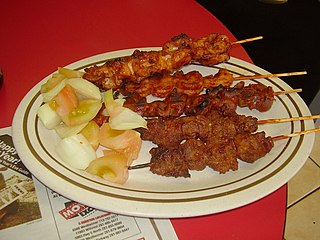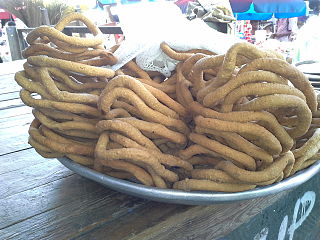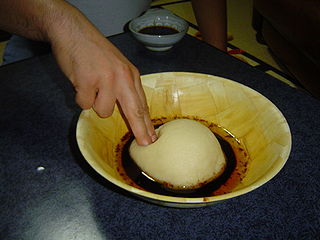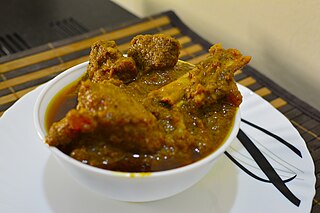
Turkish cuisine is the cuisine of Turkey and the Turkish diaspora. The cuisine took its current form after numerous cultural interactions throughout centuries, descending from earlier stages of Turkish cuisine, Ottoman cuisine and Seljuk cuisine. Turkish cuisine with traditional Turkic elements such as yogurt, ayran, kaymak, exerts and gains influences to and from Mediterranean, Balkan, Middle Eastern, Central Asian and Eastern European cuisines.

Jerky or “charqui” is lean trimmed meat cut into strips and dehydrated to prevent spoilage. Normally, this drying includes the addition of salt to prevent bacteria growth. The word "jerky" derives from the Quechua word ch'arki which means "dried, salted meat".

Biltong is a form of air-dried, cured meat which originated in South Africa, and from there spread to other Southern African countries --. Various types of meat are used to produce it, ranging from beef to game meats such as ostrich or kudu. The cut may also vary being either fillets of meat cut into strips following the grain of the muscle, or flat pieces sliced across the grain. It is related to beef jerky, as both are spiced, dried meats; however, the typical ingredients, taste, and production processes may differ. Biltong is air-dried, which gives it a unique texture and taste, whereas jerky is heated to at least 160F.

Suya, also known as "Tsire" is a traditional smoked spiced meat skewer which originates from Nigeria, and is a popular food item across West Africa. Suya is a large part of Hausa culture and food and is traditionally prepared and made by Hausa men, thus called 'Mai tsire'. While suya is the more widely recognized name in many areas of Nigeria, the Hausa community still predominantly uses the original name, tsire. Suya is generally made with skewered beef, ram, or chicken. Organ meats such as kidney, liver and tripe are also used. The thinly sliced meat is marinated in various spices, which include traditional Hausa dehydrated peanut cookie called 'kwulikwuli', salt, vegetable oil and other spices and flavorings, and then barbecued. There are many variation of Suya in traditional Hausa cooking, but the most popular being suya. Suya is traditionally served with an extra helpings of mixed dried pepper, traditional hausa spices, and sliced onions. It is also traditionally served in Hausa culture with a side serving of Hausa Masa. Halal meat preparation methods are normally used, especially in the northern parts of Nigeria where it originates as is customary with traditional Hausa foods, where the suspicion of nonconformity to Muslim dietary prohibitions in Suya preparation has been known to cause riots. A dried version of Suya is called Kilishi. It can be eaten with Masa, Kosai, Garri or Ogi.

Dried meat is a feature of many cuisines around the world. Examples include:

Assyrian cuisine is the cuisine of the indigenous ethnic Assyrian people, Eastern Aramaic-speaking Syriac Christians of Iraq, northeastern Syria, northwestern Iran and southeastern Turkey. Assyrian cuisine is primarily identical to Iraqi/Mesopotamian cuisine, as well as being very similar to other Middle Eastern and Caucasian cuisines, as well as Greek cuisine, Levantine cuisine, Turkish cuisine, Iranian cuisine, Palestinian cuisine, and Armenian cuisine, with most dishes being similar to the cuisines of the area in which those Assyrians live/originate from. It is rich in grains such as barley, meat, tomato, herbs, spices, cheese, and potato as well as herbs, fermented dairy products, and pickles.

A round steak is a beef steak from the "round", the rear end of the cow. The round is divided into cuts including the eye (of) round, bottom round, and top round, with or without the "round" bone (femur), and may include the knuckle, depending on how the round is separated from the loin. This is a lean cut and it is moderately tough. Lack of fat and marbling makes round dry out when cooked with dry-heat cooking methods like roasting or grilling. Round steak is commonly marinated when grilled, and prepared with slow moist-heat methods indoors such as braising, to tenderize the meat and maintain moisture. The cut is typically sliced thin for serving, and is popular as jerky.

Çiğ köfte or chee kofta is a kofta dish that is a regional specialty of southeastern Anatolia in Urfa. The dish is served as an appetizer or meze, and it is closely related with kibbeh nayyeh from Levantine cuisine.

Afghan cuisine is influenced by Persian, Central Asian, and South Asian cuisines due to Afghanistan's close proximity and cultural ties. The cuisine is halal and mainly based on mutton, beef, poultry and fish with rice and Afghan bread. Accompanying these are common vegetables and dairy products, such as milk, yogurt, whey, and fresh and dried fruits such as apples, apricots, grapes, bananas, oranges, plums, pomegranates, sweet melons, and raisins. The diet of most Afghans revolves around rice-based dishes, while various forms of naan are consumed with most meals. Tea is generally consumed daily in large quantities, and is a major part of hospitality. The culinary specialties reflect the nation's ethnic and geographic diversity. The national dish of Afghanistan is Kabuli palaw, a rice dish cooked with raisins, carrots, nuts, and lamb or beef.

Peanut stew or groundnut stew, also known as maafe, sauce d'arachide (French) or tigadèguèna is a stew that is a staple food in Western Africa. While maafe is a dish from Senegal, tigadéguéna originates from the Mandinka and Bambara people of Mali.

West African cuisine encompasses a diverse range of foods that are split between its 16 countries. In West Africa, many families grow and raise their own food, and within each there is a division of labor. Indigenous foods consist of a number of plant species and animals, and are important to those whose lifestyle depends on farming and hunting.

Nigerian cuisine consists of dishes or food items from the hundreds of Native African ethnic groups that comprises Nigeria. Like other West African cuisines, it uses spices and herbs with palm oil or groundnut oil to create deeply flavored sauces and soups.

Tunisian cuisine, the cuisine of Tunisia, consists of the cooking traditions, ingredients, recipes and techniques developed in Tunisia since antiquity. It is mainly a blend of Mediterranean and native Berber cuisine with Punic influences. Historically, Tunisian cuisine witnessed influence and exchanges with many cultures and nations like Italians, Andalusians, French and Arabs.

Kuli-kuli is a West African snack primarily made from peanuts, first made by the Nupe people of Nigeria. It is a popular snack in Nigeria, Benin, northern Cameroon and Ghana. Today kuli-kuli is accepted across the globe. It is often eaten alone or with a mixture of garri also known as cassava flakes, sugar and water, popularly called "garri soakings". It is also eaten with Hausa koko, fura, and akamu, and is sometimes ground and put into salad. It is often ground and used as an ingredient for suya and kilishi.

The cuisine of Libya is a mix of Berber, Arab and Mediterranean cuisines with Ottoman and Italian influence. One of the most popular Libyan dishes is bazin, an unleavened bread prepared with barley, water and salt. Bazin is prepared by boiling barley flour in water and then beating it to create a dough using a magraf, which is a unique stick designed for this purpose.

Serundeng refers to a spicy grated coconut side dish or condiment originated in Indonesia that is used to accompany rice. Serundeng may taste sweet or hot and spicy, according to the recipe variants.

Chadian cuisine is the cooking traditions, practices, foods and dishes associated with the Republic of Chad. Chadians use a medium variety of grains, vegetables, fruits and meats. Commonly consumed grains include millet, sorghum, and rice as staple foods. Commonly eaten vegetables include okra and cassava. A variety of fruits are also eaten. Meats include mutton, chicken, pork, goat, fish, lamb and beef. The day's main meal is typically consumed in the evening on a large communal plate, with men and women usually eating in separate areas. This meal is typically served on the ground upon a mat, with people sitting and eating around it.

Mutton curry is a dish that is prepared from goat meat and vegetables. The dish is found in different variations across all states, countries and regions of the Indian subcontinent and the Caribbean.



















